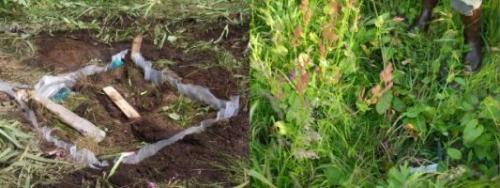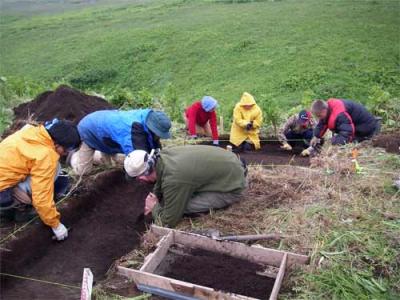So last night, after I called in my journal and emailed in my pictures, I got into my sleeping bag and tried to go to sleep. It was quite challenging, because the wind was howling so bad that I could still hear it even with my ear plugs. The worst part, however, was when the wind would blow so hard that the corner pole of my tent would become concave and whap me on the head! It was, needless to say, not a very good night’s sleep.
This morning, it was still incredibly windy when we got up for breakfast. Breakfast in camp is served at 8 am, lunch at 1 pm and dinner at 6 pm. Anastasia, our cook, is doing a tremendous job of cooking wonderful meals for us. She is even taking the time and trouble to make "onion-free” versions of the soup and main meal for me! YEAH!
During our breakfast of hot muesli and scrambled eggs with sausage and cheese, the wind continued to howl and the fog was blowing so thick that it was basically raining. We heard a few rumbles and there was much discussion about whether it was waves on the beach, gusts of wind, or rolls of thunder. There was much skepticism expressed about the thunder hypothesis…but when we went outside to investigate, we discovered that there WAS a thunderstorm moving overhead. Some of the lightning strikes were rather close – hitting the top of the point that juts out into the Sea of Okhotsk to the south of us. For the time being, at least, we were NOT going up onto the 40 meter terrace to do any work!
After about 45 minutes to an hour of lightning, thunder and pouring down rain – which we rode out in the "laboratory” tent – the storm passed to the north and we were left with just the driving wind again. We diligently spent an hour or so reinforcing our tent stakes – driving in 2-3 foot poles that we scavenged from driftwood on the beach and then tying the tent rain covers with twine and rope to them. Now all we need is a few colorful scarves and our "gypsy camp” will be complete!
By lunch time, though, the weather had completely changed again! The clouds cleared and the wind died down to the point that the Sea of Okhotsk looked like glass. The sun came out and as we set out to climb up to the top of the terrace and begin real work (archaeology, that is), we were applying sunscreen and bug spray. As soon as the wind dies, the black flies come out!
We climbed up the steep face of the terrace, which is about 40 meters high and about a 55-60 degree slope. Our plan is to do a more extensive excavation around one of the test pits that was dug last year. In this test pit, we found faunal material and some very unique artifacts, such as a disk carved out of whale bone that might have been some sort of calendar. When the test pit was backfilled last year, it was lined with plastic that was then filled with dirt. Finally, before the sod was re-laid plastic netting was put down. As you can see below, it looked much different when we found it again this year!
Test Pit 3 – 2006 vs. 2007
 The test pit at the Vodapadnaya 2 archaeological site. On the left is how it was left in 2006 - lined in plastic and netting under the sod so that it would be recognizable as a disturbed excavation. On the right is how it was found in 2007 - notice how quickly the vegetation has regrown!*
The test pit at the Vodapadnaya 2 archaeological site. On the left is how it was left in 2006 - lined in plastic and netting under the sod so that it would be recognizable as a disturbed excavation. On the right is how it was found in 2007 - notice how quickly the vegetation has regrown!*
It was decided that in addition to digging further down in the test pit itself, that we would dig a larger excavation adjacent to it. The Russians like to dig excavations that are 2 meters by 2 meters in dimension, so we began to lay out a grid that would include three, 2 m by 2m excavation units.
First, we cleared the vegetation and then we measured out the excavation grid. This is where we got to do some math!
It is important that we make the excavation units square to a level grid, not the surface of the ground. In order to do that, we first used a string to measure out one line that was straight along the ground. Then using a line level that hangs on the string and a plumb bob, we marked off 2 meter lengths and set stakes. Then we used math!
In order to make the 2 meter by 2 meter units square we couldn’t just measure out 2 meters from each of the stakes – because simply creating a four-sided figure with 2 meter side lengths does not guarantee that we would make a square, it might be a rhombus (like a squashed square). So we used some math – the Pythagorean Theorem to be exact – to figure out how to measure out a square. Can you figure out how we did it?
**So, here is your problem. We need to create a row of three, 2 m by 2 m squares. We have measured out a six meter line and marked two meter lengths along it. All we have is a few tape measures and line levels. Describe how we can use math to know how to lay out the squares so that they will BE squares (not rhombuses). ** Post your answer to me on "Ask the Team”. The first, best, complete answer could win a Japanese float collected from the Kuril Islands!
After we had measured out the grid, we worked to remove the sod so that we could get down and get dirty. We cut the sod and rolled it up so that we could replace it after we back fill the hole next week.
Preparing the Excavation Site
 A series of photos showing the preparation of the Vodapadnaya site before we begin digging.
Left - The crew works to clear the vegetation.
Middle - Ben Fitzhugh and Shelby Anderson
measure out the line for part of the excavation grid.
Right - Natasha Toropova and Volodya Gulobtsov work to roll away the sod layer.
A series of photos showing the preparation of the Vodapadnaya site before we begin digging.
Left - The crew works to clear the vegetation.
Middle - Ben Fitzhugh and Shelby Anderson
measure out the line for part of the excavation grid.
Right - Natasha Toropova and Volodya Gulobtsov work to roll away the sod layer.
The last task before we began excavating was to measure the height at the corners of the units using a surveyor’s level and a stadium rod. When that was finished, we were finally ready to begin digging!
We worked for about 90 minutes or so using trowels to clear off the first level of the excavation. This level was, by definition, "non-cultural” – meaning that it consisted of the sod and the upper layer of soil that we were considering to, at a minimum, contain only historic materials. The level was about 10 centimeters in depth and included a layer of volcanic cinders, small gravel-sized rocks which are extremely hot when they explode out during an eruption. The cinder layer was anywhere from 1-4 centimeters thick. Below the cinder layer was what we are have decided will be the beginning of level 2 in our excavation. It starts where we are first beginning to encounter bits of charcoal, fire-cracked rocks and a few flakes of rock.
Cleaning Level 1 at Vodapadnaya Site

The crew works to clean off Level 1 of the Vodapadnaya excavation site. The first level is a non-occupational layer from the sod down through a volcanic cinder layer to a layer that begins to have charcoal and artifacts such as flakes. Pictured are Taku Osaka, Colby Phillips, Matt Walsh, Dani Plante, Natasha Toropova, Volodya Gulobtsov, and Dima Shubin.
Tomorrow, we will return to the site and begin working on excavating level 2.
Just tonight, we heard from the Iskatel that more bad weather is approaching from the west. The Iskatel is moving around Simushir to the Pacific Ocean side (which is usually the rougher side) to get out into the lee and will try to pick up the tsunami group at Dushnaya Bay tomorrow. So….we will see if our tent reinforcements work and whether we will be able to do any work when we get up in the morning!
Spokonye Noche! Misty

